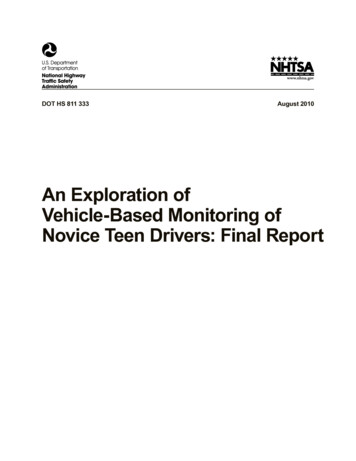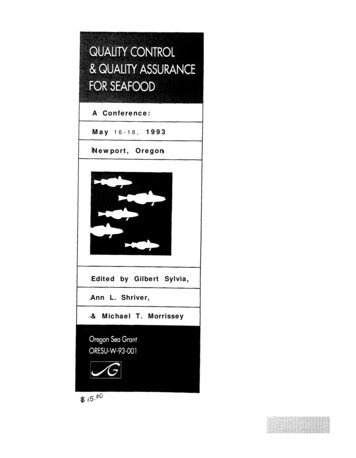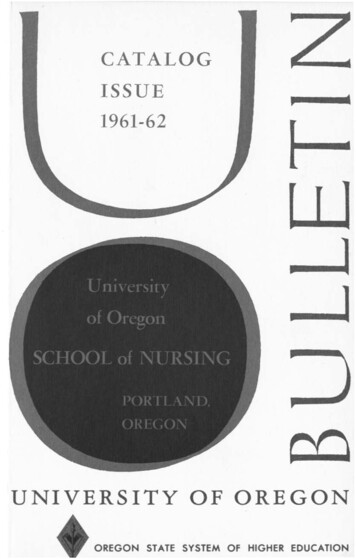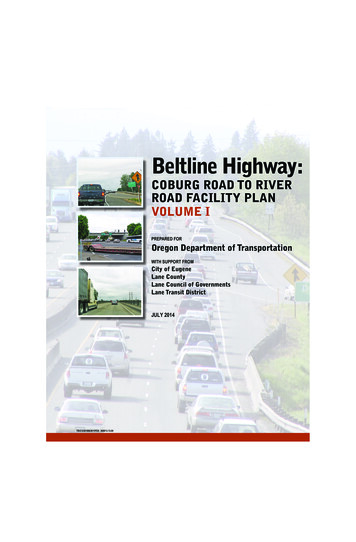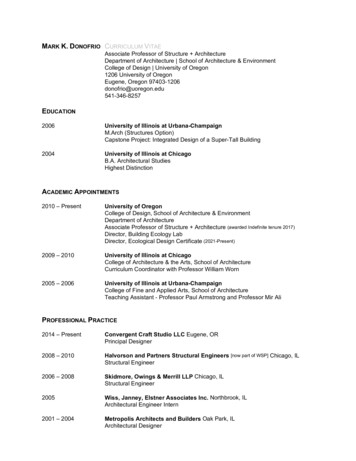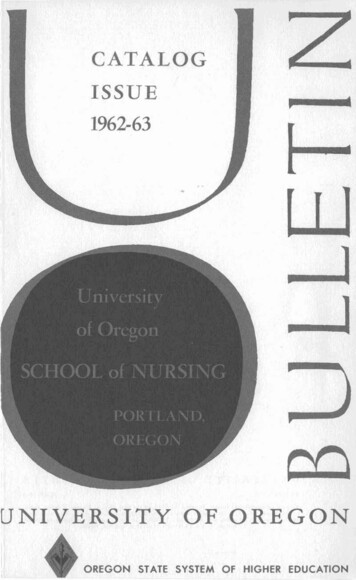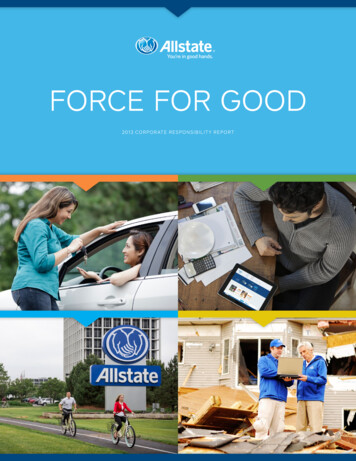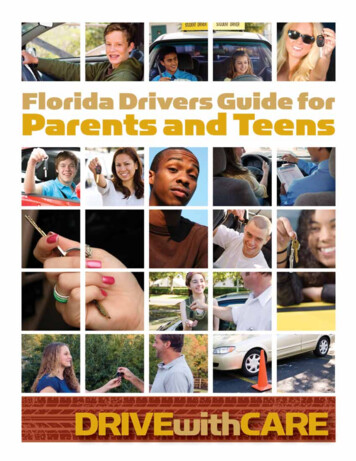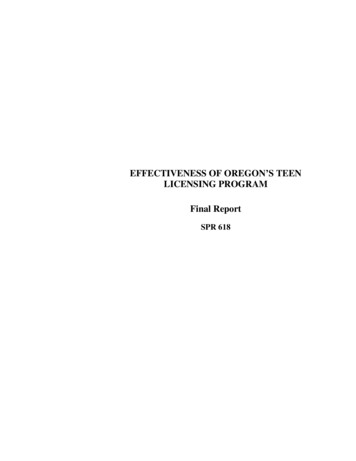
Transcription
EFFECTIVENESS OF OREGON’S TEENLICENSING PROGRAMFinal ReportSPR 618
EFFECTIVENESS OF EFFECTIVENESS OF OREGON’S TEENLICENSING PROGRAMFinal ReportSPR 618byJune H. RossODOT Research UnitforOregon Department of TransportationResearch Unit200 Hawthorne Ave. SE, Suite B-240Salem OR 97301-5192andFederal Highway Administration400 Seventh Street, SWWashington, DC 20590-0003June 2008
Technical Report Documentation Page1. Report No.2. Government Accession No.3. Recipient’s Catalog No.FHWA-OR-RD-08-124. Title and Subtitle5. Report DateJune 2008Effectiveness of Oregon’s Teen Licensing Program6. Performing Organization Code7. Author(s)8. Performing Organization Report No.June H. RossOregon Department of TransportationResearch Unit200 Hawthorne Ave. SE, Suite B-240Salem, OR 97301-51929. Performing Organization Name and Address10. Work Unit No. (TRAIS)Oregon Department of TransportationResearch Unit200 Hawthorne Ave. SE, Suite B-240Salem, OR 97301-519211. Contract or Grant No.SPR 61812. Sponsoring Agency Name and Address13. Type of Report and Period CoveredOregon Department of TransportationResearch Unitand200 Hawthorne Ave. SE, Suite B-240Salem, OR 97301-5192Final ReportFederal Highway Administration400 Seventh Street, SWWashington, DC 20590-000314. Sponsoring Agency Code15. Supplementary Notes16. AbstractSignificant changes in Oregon’s teen licensing laws went into effect on March 1, 2000. The new laws expanded theprovisional driving license program which had been in effect since October 1989 and established a graduated driverlicensing (GDL) program for all drivers under age 18. The program is intended to reduce fatal and injury crashesamong teen drivers and to promote safe driving.Two studies were completed by research organizations that were designed to assess the impact of Oregon’s teenlicensing laws. The National Highway Traffic Safety Administration (NHTSA) published a study, Evaluation ofOregon’s Graduated Driver Licensing Program, conducted by the Center for Applied Research, Inc. (CAR). TheAmerican Automobile Association financed a study, Reducing the Crash Risk for Young Drivers, which wasconducted by the Traffic Research Injury Research Foundation (TIRF) to review not only Oregon’s graduated licensingprogram but also programs in Ontario and British Columbia, Canada. Analysis of driver records as well as surveysand focus group research were included in these studies.The Oregon Department of Transportation (ODOT) has synthesized the results of these studies. This report providesbackground information, summarizes the key findings of the two reports and presents conclusions andrecommendations based on the results. The results indicate that Oregon’s graduated driver license program has safetybenefits and it should be continued.17. Key Words18. Distribution StatementGRADUATED DRIVER LICENSING PROGRAM, GDL,TEEN DRIVERS, OREGONCopies available from NTIS, and online athttp://www.oregon.gov/ODOT/TD/TP RES/19. Security Classification (of this report)UnclassifiedTechnical Report Form DOT F 1700.7 (8-72)20. Security Classification (of this page)21. No. of PagesUnclassified22. Price45Reproduction of completed page authorizediPrinted on recycled paper
SI* (MODERN METRIC) CONVERSION FACTORSAPPROXIMATE CONVERSIONS TO SI UNITSSymbolWhen YouKnowMultiply ByTo FindAPPROXIMATE CONVERSIONS FROM SI UNITSSymbolSymbolWhen You 141.61iisquare inchessquare feetsquare yardsacressquare ometersmillimeters squaredmeters squaredmeters squaredhectareskilometers illimeters squaredmeters squaredmeters squaredhectareskilometers squaredmlLm3m3mlLm3m3milliliterslitersmeters cubedmeters mi0.001610.7641.1962.470.386square inchessquare feetsquare yardsacressquare milesin2ft2yd2acmi20.0340.26435.3151.308fluid ouncesgallonscubic feetcubic yardsfl ozgalft3yd3ouncespoundsshort tons (2000 kilogramsmegagramsTEMPERATURE (exact) FinchesfeetyardsmilesVOLUMEfl ozfluid c feet0.028meters cubedyd3cubic yards0.765meters cubedNOTE: Volumes greater than 1000 L shall be shown in m3.ouncespoundsshort tons (2000 lb)SymbolAREAVOLUMEozlbTTo FindLENGTHAREAin2ft2yd2acmi2Multiply ByCelsius*SI is the symbol for the International System of Measurement0.0352.2051.102TEMPERATURE (exact) C CCelsius1.8C 32Fahrenheit F
ACKNOWLEDGEMENTSThe author would like to thank the members of the Technical Advisory Committee (TAC) fortheir assistance with this project. Persons serving on the TAC included: Rod Rosenkranz, DanThompson, Becky Renninger, and Aaron Hughes of the Driver and Motor Vehicles Division.Also on the TAC were John Harvey and Sue Riehl of the Transportation Safety Division, MarkJoerger of the Research Unit, and Nick Fortey of the Federal Highway Administration.The TAC took on the difficult task of reviewing the two reports published on Oregon’sgraduated driver license program. The TAC analyzed the data provided to determine if thefindings presented in each report were supported, and helped synthesize the results into a finalsummary report with conclusions and recommendations.Thanks also to Barnie Jones, Manager of ODOT’s Research Unit, who reviewed the report andprovided comments, and to Troy Costales, Manager of the Transportation Safety Division, whoparticipated in the discussionDISCLAIMERThis document is disseminated under the sponsorship of the Oregon Department ofTransportation and the United States Department of Transportation in the interest of informationexchange. The State of Oregon and the United States Government assume no liability of itscontents or use thereof.The contents of this report reflect the view of the authors who are solely responsible for the factsand accuracy of the material presented. The contents do not necessarily reflect the official viewsof the Oregon Department of Transportation or the United States Department of Transportation.The State of Oregon and the United States Government do not endorse products ofmanufacturers. Trademarks or manufacturers’ names appear herein only because they areconsidered essential to the object of this document.This report does not constitute a standard, specification, or regulation.iii
TABLE OF CONTENTS1.0INTRODUCTION. 11.11.2PROBLEM STATEMENT. 1GRADUATED DRIVER LICENSE PROGRAMS . 11.2.11.31.42.0Oregon’s Graduated Driver Licensing Program .3CRASH INVOLVEMENT . 4REPORT OBJECTIVES . 8REVIEW OF: REDUCING THE CRASH RISK FOR YOUNG DRIVERS REPORT .112.12.2REPORT OVERVIEW . 11REPORT CONCLUSIONS . 122.2.12.2.22.2.32.2.42.2.52.2.62.2.72.2.8Crash Involvement .12Early Intervention.12Passenger Restrictions.12Nighttime Driving Restrictions .13Role of Practice Driving.13Driver Education .13Parental Involvement.14Support for Laws .143.0REVIEW OF: EVALUATION OF OREGON’S GRADUATED DRIVER LICENSINGPROGRAM REPORT . 153.1REPORT OVERVIEW . 153.1.13.1.23.2REPORT CONCLUSIONS3.2.13.2.23.2.34.04.14.25.0Focus Groups .15Analysis of Driver Performance Data .15. 16Conclusions Based on Focus Group Research.16Conclusions Based on Analysis of Driver Performance Data.17Safety Impact of Driver Education .18CONCLUSIONS AND RECOMMENDATIONS. 19CONCLUSIONS . 19RECOMMENDATIONS . 20REFERENCES. 23APPENDICESAppendix A: Oregon Statutes Related to Youth Driver Licensingiv
LIST OF FIGURESFigure 1.2: Teen drivers involved in fatal and injury crashes, 1985-2006 .5Figure 1.2: Percent of all drivers in fatal and injury crashes that were 16 or 17 years old, 1985-2006 .7Figure 1.3: Fatal and injury crash rate, 16- and 17-year-old drivers, 1985-2006.8LIST OF TABLESTable 1.1: Comparison of Oregon's GDL program to the Insurance Institute of Highway Safety’s "DesirableComponents”.2Table 1.2: Comparison of fatal and injury crash involvement in Oregon, 1999 and 2004.6v
1.0 INTRODUCTION1.1PROBLEM STATEMENTSignificant changes in Oregon’s teen licensing laws went into effect on March 1, 2000. The newlaws expanded the provisional driver licensing program which had been in effect since October1989 and established a graduated driver licensing (GDL) program for all drivers under age 18.The program is intended to reduce fatal and injury crashes among teen drivers and to promotesafe driving.1.2GRADUATED DRIVER LICENSE PROGRAMSFewer teen drivers are now involved in traffic crashes because most states, including Oregon,have implemented changes in their teen driving laws. The Graduated Driver License (GDL) isdesigned to address the inexperience and risk taking behaviors of young drivers. Extensiveresearch shows that young drivers are especially at risk when driving: at night; after drinking alcohol or using other drugs; and with passengers in the vehicle.The Insurance Institute for Highway Safety (IIHS) has established guidelines for GraduatedDriver License Programs:Graduated licensing is a system designed to delay full licensure while allowing beginnersto obtain their initial experience under lower risk conditions. There are three stages: aminimum supervised learner's period; an intermediate license (once the driving test ispassed) that limits unsupervised driving in high-risk situations; and a full-privilegedriver's license available after completion of the first two stages. Beginners must remainin each of the first two stages for set minimum time periods . In an optimal system, theminimum age for a learner's permit is 16; the learner stage lasts at least 6 months, duringwhich parents must certify at least 30-50 hours of supervised driving; and theintermediate stage lasts until at least age 18 and includes both a night driving restrictionstarting at 9 or 10 p.m. and a strict teenage passenger restriction allowing no teenagepassengers, or no more than one teenage passenger (IIHS, Highway Loss Data Institute2008).See Table 1.1 which compares the components of Oregon’s program with the IIHS guidelines.1
Table 1.1: Comparison of Oregon's GDL program to the Insurance Institute of Highway Safety’s "DesirableComponents”“Desirable Components” (Insurance Institute forHighway Safety)Oregon's Graduated License ProgramLearner's PhaseInstruction Driver PermitMinimum age to receive permit is 16.May receive permit at age 15 (ORS 807.280(2)(a)Require supervision by a fully licensed driver whois at least age 21Require supervision of person 21 or older with valid license (ORS807.280(5))Require 50 hours of supervised driving and either drivers education(normally 24 hours classroom and 6 hours behind the wheel) or anadditional 50 hours of supervised driving (ORS 807.065). Superviseddriving must be with a person age 21 or older who has had a valid licensefor at least 3 yearsRequire 30-50 hours of certified driving, some ofwhich should be nighttime driving. If drivereducation is required it should be integrated tocomplement graduated licensingMust have learner's permit for at least 6 monthsMust have instruction driver permit for at least 6 months (ORS 807.065)Intermediate StageProvisional LicenseUnsupervised driving not permitted before age 16and not until have had a learner’s permit for atleast 6 monthsUnsupervised driving allowed at age 16Restrict unsupervised night driving between 9 or10 PM and 5 AM, except under certain conditionsRestrict unsupervised driving between midnight and 5 AM, except undercertain conditions, for first year or until age 18. (ORS 807.122 (b))Limit teenage passengers to 0 or 1 during some orall of the intermediate phase, unless an adult ispresentHold beginning drivers in the intermediate stageuntil at least age 18Consider an exit driving test to ensure competenceprior to full licensure.Include penalty provisions that delay full licensurefor beginners with poor driving record.For first 6 months no passenger under the age of 20 is allowed who isn't amember of their immediate family; for the second 6 months no more than3 passengers under the age of 20 are allowed who aren’t a member of theirimmediate family. (ORS 807.122 (a)).Hold beginning drivers in provisional license stage until age 18, butpassenger and night driving restrictions end in 1 year or at age 18,whichever comes first. Other restrictions and the provisional driverimprovement program apply until age 18.No exit driving test, but required written examination to test knowledgeand understanding of safe driving practices prior to obtaining provisionallicense. (ORS 807.065 (b))Driver Improvement Program restrictions are more stringent for driversunder age 18. DMV will restrict driving privileges for 90 days to a personwho has 2 driver improvement violations, 2 preventable accidents, or acombination. Can drive only for work purposes without passengers,except parent, stepparent or guardian. DMV will suspend drivingprivileges of a driver with 3 driver improvement violations, 3 preventableaccidents, or a combination. Increased suspension periods apply foradditional traffic crimes. (ORS 809.480 and OAR 735-072-0023)Full Driving PrivilegesFull Driving PrivilegesPassenger restrictions in effect until at least age 17Nighttime driving restrictions in effect until atleast age 18Passenger restrictions in effect until at least age 17Nighttime driving restrictions in effect until at least age 17Significant research has been done on GDL programs. This report focuses on the findings of tworecently-published studies that addressed Oregon’s GDL program and does not investigate anyof the other studies on this topic. For readers interested in other current research on this topic, a2
special issue of the Journal of Safety Research, “Novice Teen Driving; GDL and Beyond –Research Foundations for Policy and Practice Symposium”, reports on much of the most recentresearch (National Safety Council 2007).1.2.1 Oregon’s Graduated Driver Licensing ProgramChanges were made to Oregon’s provisional licensing program in 2000. Prior to those changes,elements of Oregon's provisional license program included: safe-driving practices knowledge test; 28-day waiting period between attempts, for drivers who fail the road test; suspension for any measurable blood alcohol; suspension until age 18 for any major traffic conviction; accelerated driver improvement program; and the license heading “Provisional Driver License,” and the license showing “minoruntil ” date, indicating the date a person turned 21.In 1999 the Oregon legislature added tougher qualifications for 16 and17 year olds to get alicense, more restrictions during the first year of licensure, and stricter penalties when laws areviolated. The graduated driver license law which went into effect in March 2000 includes, inaddition to the requirements already in place, the following elements: an instruction permit for six months prior to issuance of full driving privileges; completion of at least 50 hours of supervised driving experience and an approved driverseducation course or parent certification of completion of at least 100 hours of superviseddriving experience; Passenger and nighttime driving restrictions which, when violated, can result in issuanceof a citation (ORS 807.010(2)) if the police officer has probable cause to make a stop:9 for the first six months after obtaining the license, no occupants can be in the car whoare under age 20, except immediate family members;9 for the second six months, no more than three passengers who are under age 20 canbe in the car, except immediate family members;(Passenger restrictions do not apply while the provisional driver is driving with aninstructor as part of a certified traffic safety education course or with a parent orstepparent who has valid driving privileges.)9 for the first twelve months, no driving is allowed between midnight and 5 a.m. exceptbetween home and work, between home and a school event for which there is noother transportation available; for employment purposes; or if accompanied by alicensed driver who is at least 25 years old; Longer periods of license restriction and suspension if traffic laws are violated. Underthe Provisional Driver Improvement Program, drivers with two driver improvement3
violations or crashes, or a combination, will have their driving privileges restricted for 90days to drive to and from work only. Driver and Motor Vehicle Services (DMV) mayrequire the driver to complete a defensive driving course or re-take license tests.Subsequent violations or accidents will lead to a six month license suspension which willcontinue to be in effect even if the driver turns 18; A distinctive license. All drivers under the age of 21 have a red border around the edgesof the card with the date the licensee turns ages 18 and 21. The photo is distinguishablebecause of its placement on the right side of the license instead of the left. For driversunder 18 the license heading states “Provisional Driver License”.)Oregon has additional laws that require school attendance or proof of graduation and allowsparents to withdraw their consent of driving privileges for their son or daughter who is under theage of 18.A comprehensive public information program directed at teens and their parents was launchedprior to the implementation of the GDL program. DMV continues to have public informationmaterials available on its website Materials include a Transportation Safety Division publication “The Road to Getting YourLicense” and a Practice Driving Log for tracking practice hours. When the graduated licensingprogram first was implemented, a manual called “Tuning Up” was offered to parents when theirson or daughter got an instructional permit. There is now a publication called “The OregonParent Guide to Teen Driving” that includes a driving log so parents can keep track of superviseddriving time.1.3CRASH INVOLVEMENTThe number of young drivers involved in fatal and injury crashes has declined significantly sincethe GDL program was implemented in March 2000. Figure 1.2 shows the changes in the numberof teenage drivers involved in fatal and injury crashes since 1985. The year the GDL programwas implemented is marked. The reduction in crash involvement of 16 year old drivers has beenparticularly dramatic. In 1998 there were 1,195 16 year-old drivers involved in fatal and injurycrashes; in 1999, 1,078; in 2000, 898; and the numbers continued to decline so that in 2006, 65816-year-old drivers were involved in fatal and injury crashes in Oregon.4
Drivers in Fatal and Injury Crashes2,50016172,0001819GDLimplementedMarch 00120032005YearFigure 1.2: Teen drivers involved in fatal and injury crashes, 1985-2006The reduction in teen driver involvement in fatal and injury crashes from 1985 to 2006 issignificant, but, overall, teens are overrepresented in motor vehicle crashes. To take a closerlook at this, we have calculated the rate of involvement of teens in fatal and injury crashes usinglicensed driver data and compared this to the rate of involvement of all drivers. Though the useof licensed driver data as a measure of exposure is not as representative as vehicle miles traveled(VMT), VMT data is not available. We can speculate that younger teens probably drive fewermiles than older teens, but it is not possible to determine the vehicle miles traveled by age.ODOT has used 1998 as the base year for analysis in its public information reports about theimpact of the teen driving program due to concern that 1999 data might be tainted by theinfluence of early licensure of teens wishing to avoid upcoming requirements. Unfortunately,the driver license data which was needed for the analysis included in this research report was notavailable for 1998. Table 1.2 shows the rate of involvement (using licensed driver data) ofdrivers in fatal and injury crashes, by age, for the years 1999 and 2004. These years wereselected to represent the period prior to the implementation of the expanded provisional licenseprogram and the year by which all teenage drivers had been exposed to the requirements of theprogram. Our use of 1999 data rather than 1998 data for the analysis does not imply that thecomparisons previously presented in other reports are incorrect.5
Table 1.2: Comparison of fatal and injury crash involvement in Oregon, 1999 and 200419992004% ChangeDriversRateDriversRatein RateLicensedin F&I/1000Licensedin 65.1%16-19All drivers(16 1,37536,27713.32,893,59134,78112.09.8%Sources: ODOT Crash Analysis and Reporting System and DMV. Licensed driver data is from “Drivers of Issuance by Age” report andreflects the number of drivers of each age licensed at end of the calendar year.Specific observations: The rate of involvement in fatal and injury crashes of 16-year-old drivers has declined byover 25%, which is more than twice the decline for all drivers, but the rate of involvement ofolder teenagers (18 and 19) has declined less than for the rest of the driving population. Teenage drivers continue to have more than twice the rate of involvement in fatal and injurycrashes as compared to all drivers. The number of licensed teenage drivers (16-19) decreased by 9.2% from 1999 to 2004 while,in the same period, the number of all licensed drivers in the state increased by 6.3%. Also,according to official state population estimates, during that same time period, the Oregonteenage population increased. Both suggest that the graduated license program is having theadditional effect of delaying licensure. Table 1.2 shows that the proportion of licensedteenagers who are 16-17 has declined since the GDL program went into effect; and, to alesser extent, the proportion of older teenagers who are licensed has also declined.Considering the effects of delayed licensing, the rate of crashes per licensed driver mayseverely underestimate the per capita crash rate. Unfortunately population estimates byspecific age are not available.Figure 1.2 illustrates the reduction in the involvement of teen drivers in fatal and injury crashesas a percentage of the involvement of all drivers during the last 20 years. In 1985, 6.9% ofdrivers involved in fatal and injury crashes were under 16 or 17 years old; in 2006, 4.4% ofdrivers involved in fatal and injury crashes were 16 or 17.6
7198919911993199519971999200120032005YearSource: ODOT, Crash Analysis and Reporting System (CARS)Figure 1.2: Percent of all drivers in fatal and injury crashes that were 16 or 17 years old, 1985-2006Additional observations: Even before the introduction of the provisional license program in 1989 the percent of alldrivers that were 16 or 17 years old that were involved in fatal and injury crashes had begunto decline. With the provisional license program, the relative involvement of teens in fataland injury crashes remained relatively steady for several years, but in the late 1990’s thetrend reversed itself. With the introduction of the graduated driver licensing program in 2000, the involvement of16- and 17-year-old drivers in fatal and injury crashes returned to about the same level asimmediately after the implementation of the provisional driver license program in 1989. The downward trend has continued.Another way of looking at the changes in the involvement of teens in crashes is to look at theirrate of involvement based on the number of licensed drivers. In Figure 1.3 crash rates per 1,000drivers aged 16 and 17 is presented. Crash data is from ODOT’s Crash Analysis and ReportingUnit. Driver license data is from the Driver and Motor Vehicle Services.7
Age 17Age 1619951997Fatal and Injury Crash Rate Per 199119931999200120032005YearSource: ODOT (Crash Analysis and Reporting Unit and DMV). DMV data for 1999 (marked by a dotted line) to 2006 is from the “Driversof Issuance by Age” report and has been determined to be consistent over time. Data for 1985 to 1997 is from driver population reportsgenerated by DMV. Due to changes made to the data system, there appears to have been a significant underreporting of licensed drivers in allage categories in 1998. For this reason, 1998 data was interpolated using 1997 and 1999 data.Figure 1.3: Fatal and injury crash rate, 16- and 17-year-old drivers, 1985-20061.4REPORT OBJECTIVESThe purpose of this report is to review, analyze and synthesize the results of two evaluativereports on the Oregon GDL program: Reducing the Crash Risk for Young Drivers (Mayhew et al.2006) and Evaluation of Oregon’s Graduated Driver Licensing Program (Raymond et al. 2007).The findings of these reports will help ODOT examine the effectiveness of the Graduated DriverLicensing program and identify the elements of the program that offer the most crash reductionbenefits.The report, Reducing the Crash Risk for Young Drivers, was published in June 2006 (Mayhew etal.). The American Automobile Association (AAA) Foundation for Traffic Safety financed astudy conducted by the Traffic Research Injury Research Foundation (TIRF) which reviewed notonly Oregon’s graduated licensing program but also programs in Ontario and British Columbia,Canada. This study included interviews of both parents and teens which were conducted by theOregon Survey Research Laboratory (OSRL).The other report, Evaluation of Oregon’s Graduated Driver Licensing Program, was publishedin September 2007 (Raymond et al.). The National Highway Traffic Safety Administration(NHTSA) supported the study conducted by the Center for Applied Research, Inc. (CAR). This8
study included 14 focus groups of parents, teens, DMV road test administrators, drivinginstructors, police officers, and high school administrators and the analysis of driver records.Oregon Department of Transportation Research Unit has, with the assistance of a TechnicalAdvisory Committee (TAC), reviewed both reports and prepared a summary intended to identifythose elements of Oregon’s GDL program that are effective and aspects of the program thatcould be strengthened.Our review process involved identifying the conclusions that related to Oregon’s teen driverpopulation and determining if the crash data analysis and survey results supported them. TheTAC formed to complete the review of the two reports represented program managersresponsible for licensing and
Significant changes in Oregon's teen licensing laws went into effect on March 1, 2000. The new laws expanded the provisional driving license program which had been in effect since October 1989 and established a graduated driver licensing (GDL) program for all drivers under age 18. The program is intended to reduce fatal and injury crashes
